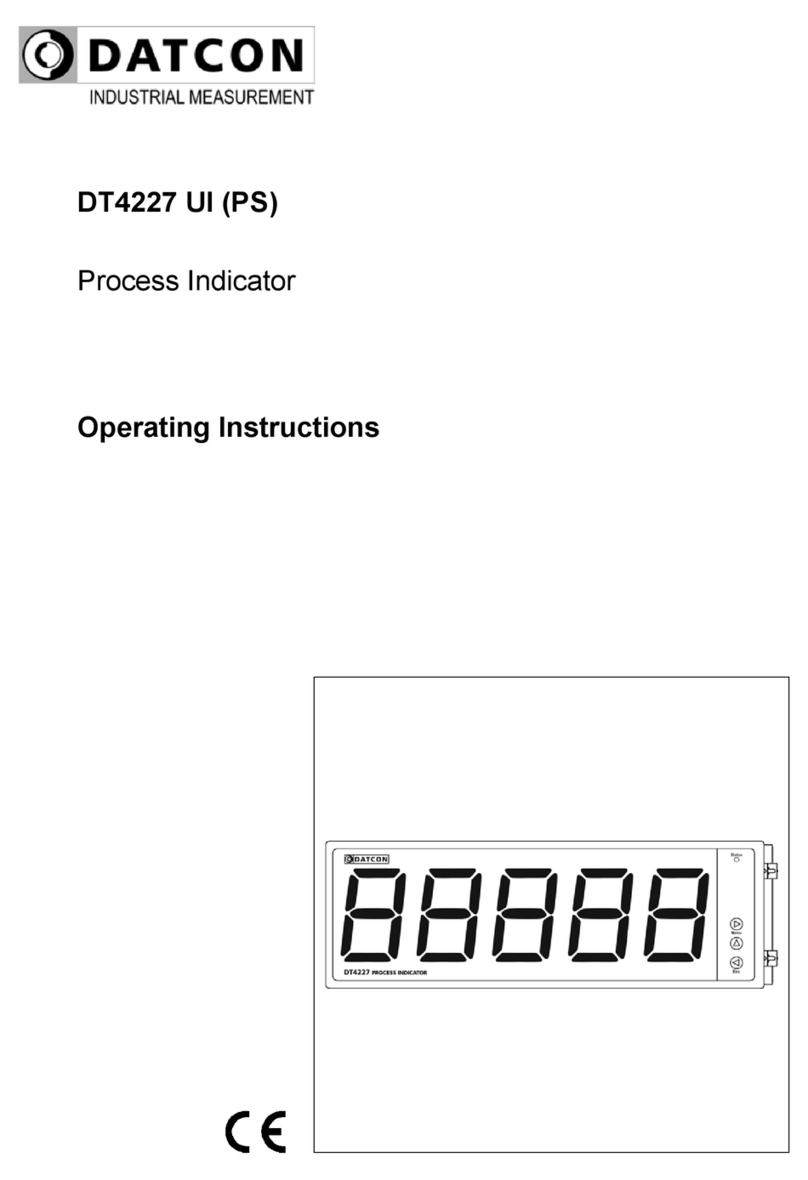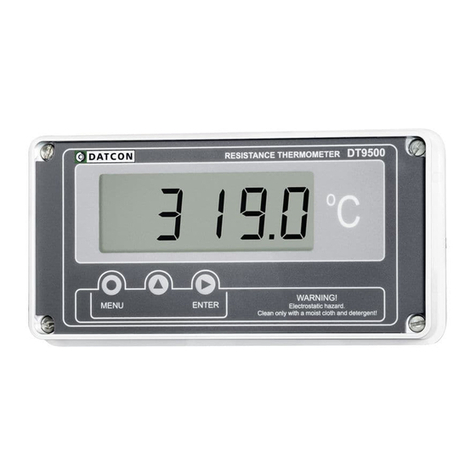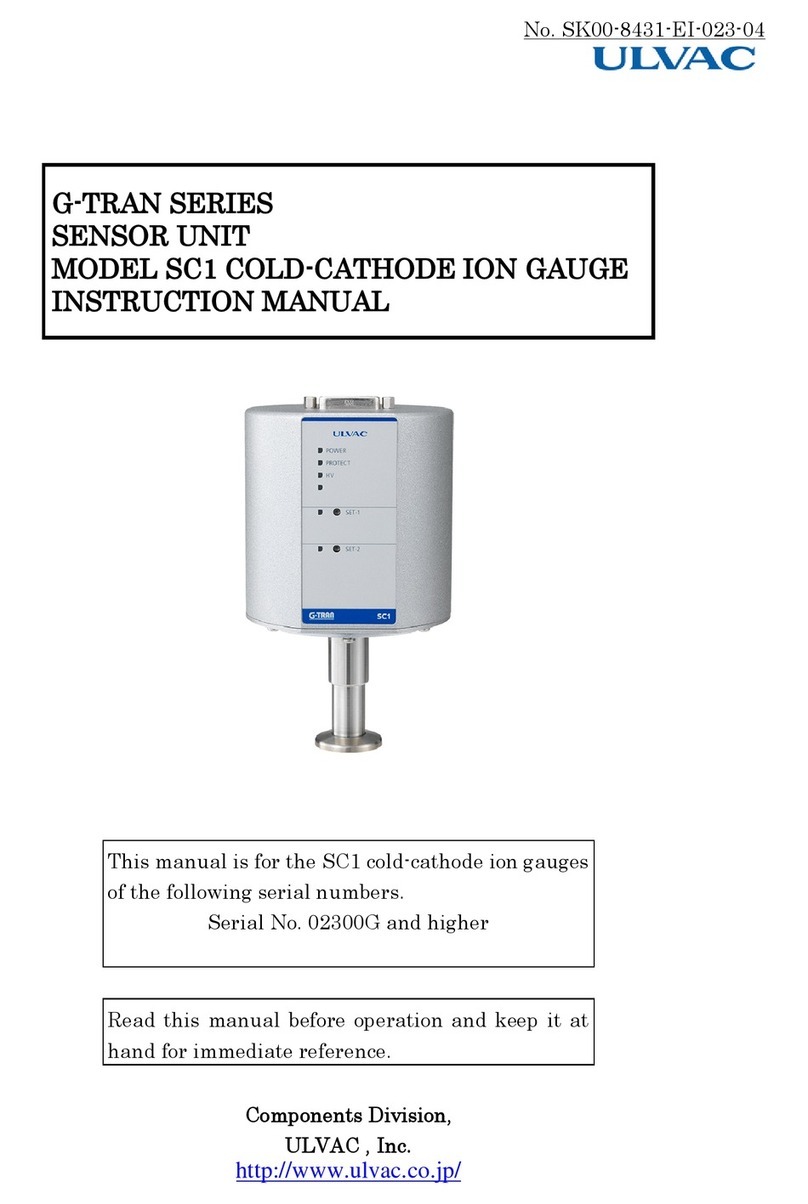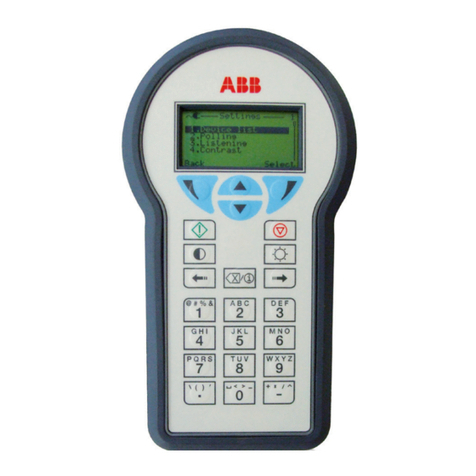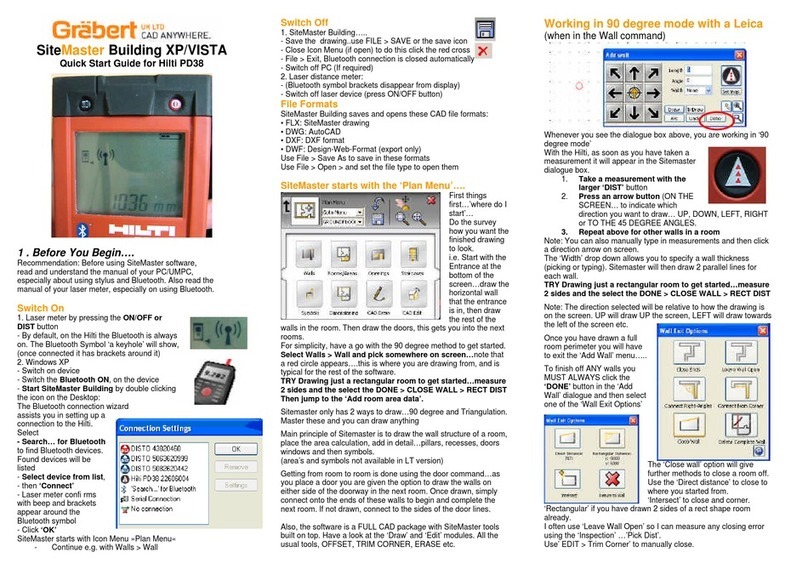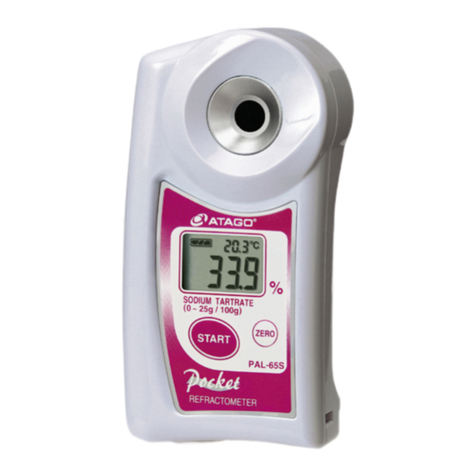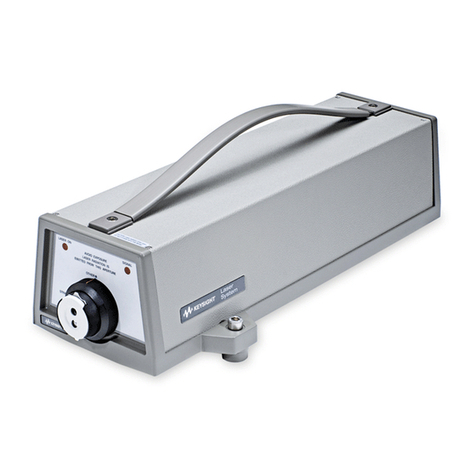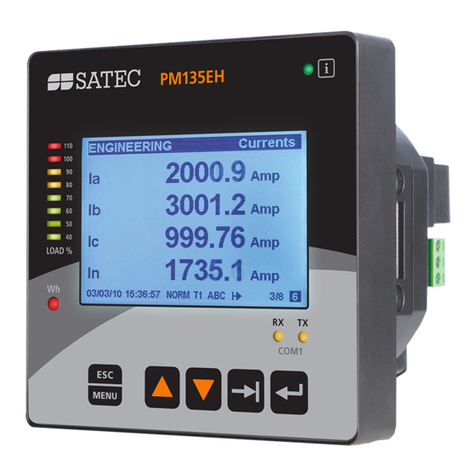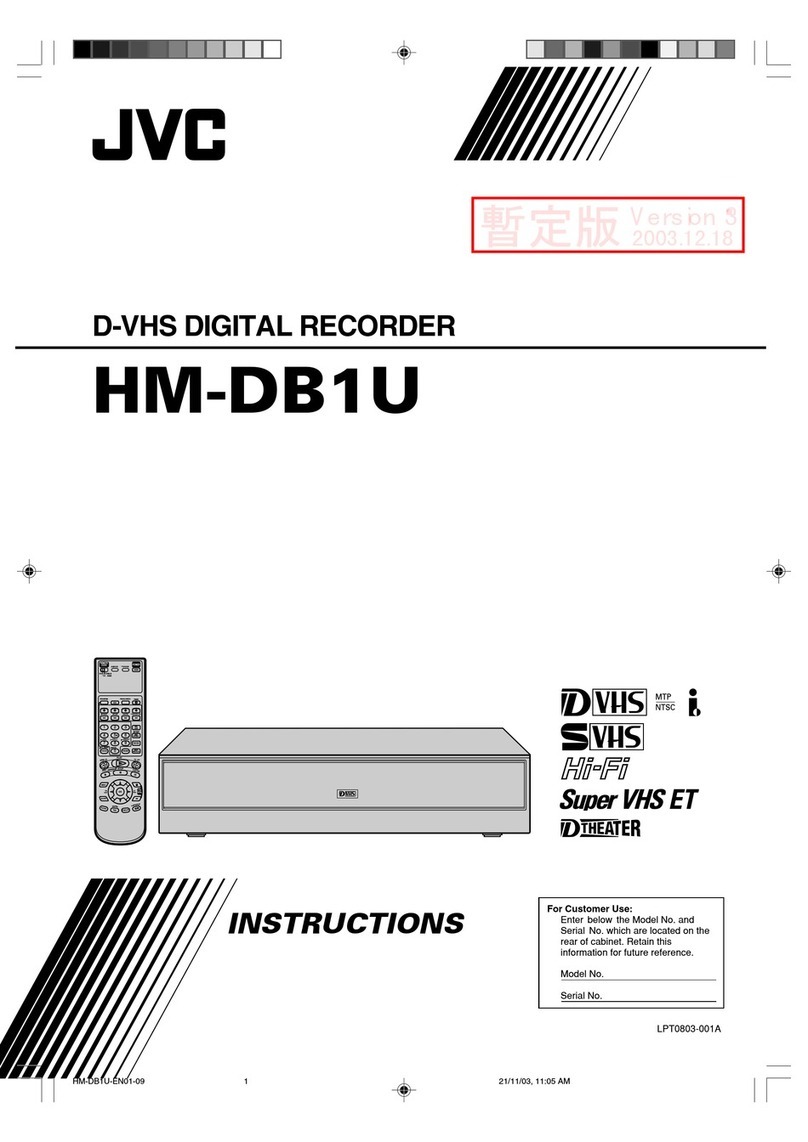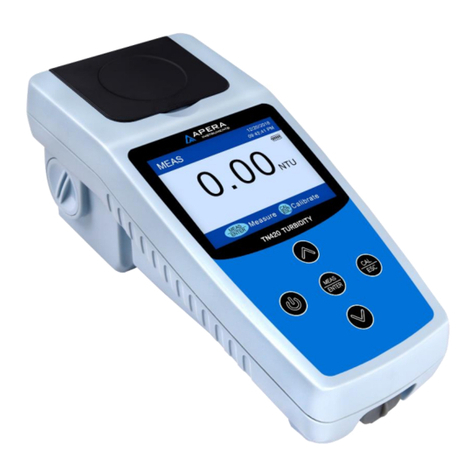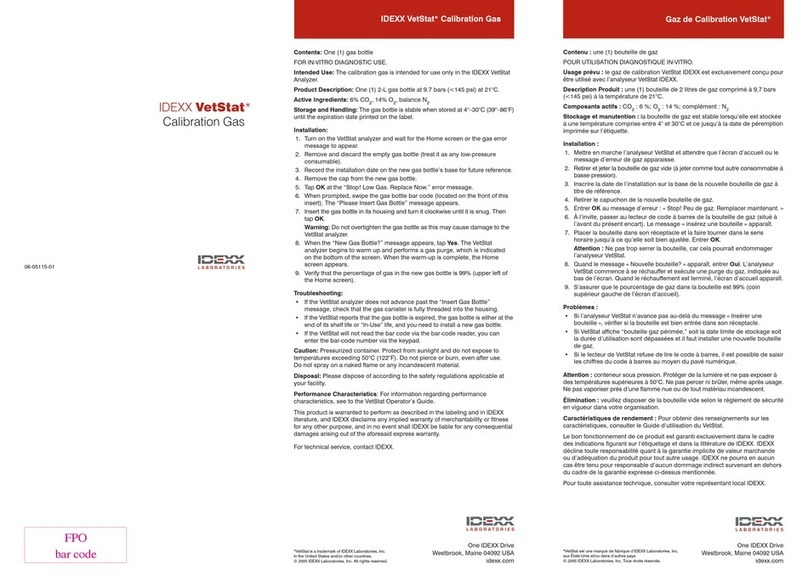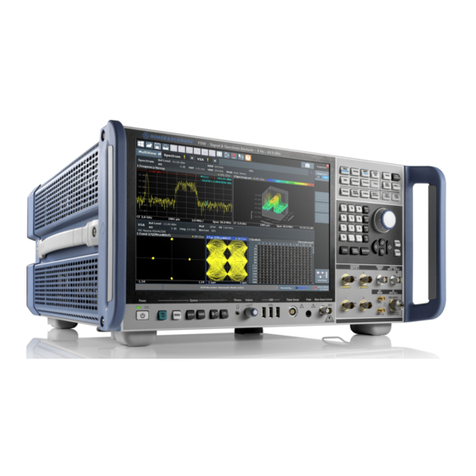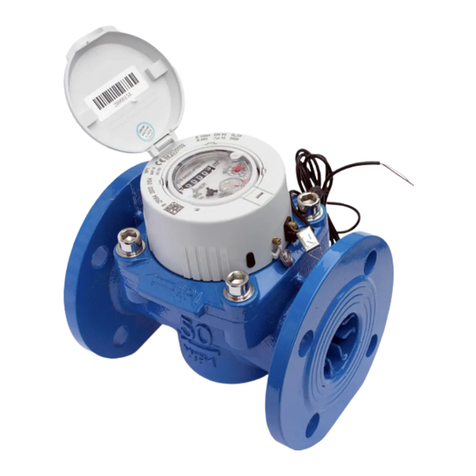Datcon DT1102 V User manual

DT1102 V (PS)
Fully Configurable Galvanic Isolator
Operating Instructions

DT1102 V
2 20230127-V0
Contents
1. About this document..............................................................4
1.1. Function...............................................................................................4
1.2. Target group........................................................................................4
1.3. Symbolism used .................................................................................. 4
2. For your safety........................................................................5
2.1. Authorized personnel...........................................................................5
2.2. Appropriate use ...................................................................................5
2.3. Warning about misuse......................................................................... 5
2.4. General safety instructions ..................................................................5
2.5. CE conformity......................................................................................5
2.6. Environmental instructions...................................................................5
3. Product description................................................................6
3.1. Delivery configuration .......................................................................... 6
3.2. Type designation .................................................................................6
3.3. Operating principle .............................................................................. 7
3.4. Adjustment ..........................................................................................8
3.5. Indicators, USB connector................................................................... 9
3.6. Storage and transport.......................................................................... 9
4. Mounting ...............................................................................10
4.1. General instructions........................................................................... 10
4.2. Main dimensions of the instrument .................................................... 10
4.3. Mounting procedure........................................................................... 11
5. Connecting............................................................................12
5.1. Preparing the connection................................................................... 12
5.2. Connecting the DC current signal source .......................................... 13
5.3. Connecting a -2.5 - +2.5 VDC voltage signal source ......................... 14
5.4. Connecting a -125 - +125 VDC voltage signal source ....................... 15
5.5. Connecting the signal processing unit and the power supply............. 16
5.6. Put the instrument under supply voltage.Hiba! A könyvjelzőnem létezik.
5.7. Connecting to PC via USB cable ....................................................... 18

DT1102 V
20230127-V0 3
6. The first start-up, indicators ................................................19
6.1. The first start-up ................................................................................ 19
6.2. Indicator LED-s................................. Hiba! A könyvjelzőnem létezik.
7. Setting-up..............................................................................21
7.1. First steps.......................................................................................... 21
7.2. Analogue input type setting ............................................................... 23
7.3. Analogue input range setting ............................................................. 24
7.4. Analogue output type setting ............................................................. 25
7.5. Analogue output range setting........................................................... 26
7.6. Resetting default setting .................................................................... 27
7.7. Display measured data...................................................................... 28
7.8. Display system information................................................................ 28
7.9. Display errors .................................................................................... 29
8. Fault rectification..................................................................30
8.1. Fault finding....................................................................................... 30
8.2. Repairing ........................................................................................... 30
9. Dismounting..........................................................................31
9.1. Dismounting procedure...................................................................... 31
9.2. Disposal............................................................................................. 31
10. Appendix .............................................................................32
10.1. Technical specification..................................................................... 32
10.2. Application example ........................................................................ 35

DT1102 V
4 20230127-V0
start 1. About this document
1.1. Function
This operating instructions manual has all the
information you need for quick set-up and
safe operation of DT1102 V (PS).
Please read this manual before you start setup.
1.2. Target group
This operating instructions manual is directed to trained personnel.
The contents of this manual should be made available to these
personnel and put into practice by them.
1.3. Symbolism used
Information, tip, note
This symbol indicates helpful additional information.
Caution, warning, danger
This symbol informs you of a dangerous situation that could occur.
Ignoring this cautionary note can impair the person and/or the
instrument or it’s environ.
•List
The dot set in front indicates a list with no implied sequence.
→
Action
This arrow indicates a single action.
1
Sequence
Numbers set in front indicate successive steps in a procedure.

DT1102 V
20230127-V0 5
2. For your safety
2.1. Authorized personnel
All operations described in this operating instructions manual must be
carried out only by trained and authorized specialist personnel. For
safety and warranty reasons, any internal work on the instruments
must be carried out only by DATCON personnel.
2.2. Appropriate use
The DT1102 V (PS) is a Fully Configurable Galvanic Isolator for
industrial use. Detailed information on the application range is
available in chapter 3. Product description.
2.3. Warning about misuse
Inappropriate or incorrect use of the instrument can give rise to
application-specific hazards, or damage to system components
through incorrect installing or adjustment.
2.4. General safety instructions
Using the DT1102 V (PS) Fully Configurable Galvanic Isolator
requiring the strict observance of standard regulations and guidelines.
The user must take note of the safety instructions in this operating
instructions manual, the country-specific installation standards as well
as all prevailing safety regulations and accident prevention rules.
2.5. CE conformity
The DT1102 V (PS) is in conformity with the provisions of the following
standards:
MSZ EN 61326-1 (EMC)
MSZ EN 61010-1 (Safety)
2.6. Environmental instructions
Protection of the environment is one of our most important duties.
Please take note of the instructions written in the following chapters:
•Chapter 3.6. Storage and transport
•Chapter 9.2. Disposal

DT1102 V
6 20230127-V0
3. Product description
3.1. Delivery configuration
Delivered items The scope of delivery encompasses:
•DT1102 V (PS)
•documentation:
this operating instructions manual
certification
warranty
3.2. Type designation

DT1102 V
20230127-V0 7
3.3. Operating principle
Area of application The DT1102 V (PS) Fully Configurable Galvanic Isolator provide
signal transmission and conversion between DC current or DC voltage
signal source and signal processing units.
The instruments feature complete 3-way isolation: the input, the
output and the power supply are isolated from each other.
The instruments has three inputs:
1./ -25 mA - +25 mA DC current,*
2./ -2.5 - +2.5 V DC voltage,*
3./ -125 - +125 V DC voltage.*
The instruments has two outputs:
1./ 0 - 22 mA DC current,*
2./ 0 – 10.5 V DC voltage.*
* You must use one input and one output at a time.
The PC configurator software is accessory or free downloadable from
homepage: www.datcon.hu
The input type and range and the output type and range are
configurable (current or voltage). See chapter 10.1. Technical
specification.
The input is bipolar, symmetrical.
The output is unipolar.
The configuration parameters can be download from
the PC to the DT1102 V via USB port.
The front panel LED indicators provide information about the
operating status of the device.
Principle of operation
The input current flows through the measuring resistor or the input
voltage is divide by the attenuator. This voltage is measured by a 24-
bit A/D converter. The digital output signal of the A/D converter is
processed by a microcontroller.
The microcontroller produces a pulse width modulated output signal
which is proportional to the processed, scaled measuring value. The
output pulse is galvanic isolated by an opto coupler. After filtering the
pulse is converted into analogue current or voltage signal.
Connecting the instrument to the PC through the USB interface the
instrument’s communication circuitry come into active state and it is
ready for communication with the configuration software.

DT1102 V
8 20230127-V0
The USB port is galvanic isolated therefore the USB cable can
plugged into a grounded PC too.
Power supply The DT1102 V (PS) is available two different power supply:
DT1102 V:
Power Supply: 24 VDC ±10%
DT1102 V PS:
Power Supply: 230 V AC/DC ±10%
3.4. Adjustment
After connecting the DT1102 V is ready to work with the factory
default parameters are written in chapter 6.1. The first start-up. For
working with the default parameters there is no need any adjustment.
The detailed description of the setup can be found in chapter 7.
Setting-up.

DT1102 V
20230127-V0 9
3.5. Indicators, USB connector
The following figure shows the indicators and USB connector on the
DT1102 V front panel.
1. USB-B mini, 5 pole connector for connecting to the PC at
configuration.
2. The „error” red indicator blinking light indicates different error states.
3. The „on” green indicator continuous light indicates that the
instrument is working.
3.6. Storage and transport
This instrument should be stored and transport in places whose
climatic conditions are in accordance with chapter 10.1. Technical
specification, as described under the title: Ambient conditions.
The packaging of DT1102 V consist of environment-friendly,
recyclable cardboard is used to protect the instrument against the
impacts of normal stresses occurring during transportation. The
corrugated cardboard box is made from environment-friendly,
recyclable paper. The inner protective material is polyfoam and nylon,
which should be disposed of via specialized recycling companies.

DT1102 V
10 20230127-V0
4. Mounting
4.1. General instructions
The instrument should be installed in a cabinet with sufficient IP
protection, where the operating conditions are in accordance with
chapter 10.1. Technical specification, as described under the title:
Ambient conditions.
Mounting position
The instruments are designed in a housing for mounting on TS-35 rail.
The instruments should be mounted in vertical position (horizontal rail
position).
Horizontal mounting may cause overheating and damage of the
instrument.
4.2. Main dimensions of the instrument
The following figure shows the main dimensions of the instrument.

DT1102 V
20230127-V0 11
4.3. Mounting procedure
The following figure shows the mounting procedures (fixing on the
rail):
Mounting on the rail
The mounting doesn’t need any tool.
1. Tilt the instrument according to the figure; put the instrument’s
mounting hole onto the upper edge of the rail (figure step 1.).
2. Push the instrument’s bottom onto the bottom edge of the rail
(figure step 2.), you will hear the fixing assembly closing.
3. Check the hold of the fixing by moving the instrument firmly.

DT1102 V
12 20230127-V0
5. Connecting
5.1. Preparing the connection
Select connection
cable
Preparing cables
Always observe the following safety instructions:
• The connection must be carried out by trained and authorized
personnel only!
• Connect or disconnect only in the complete absence of supply
voltage
• You should take note the data concerning on the overcurrent
protection in installation
• Use only a screwdriver with appropriate head.
Take note the suitability of the connecting cable
(wire cross-section, insulation, etc.).
The wire cross-section should be 0.25-1.5 mm2.
You may use either solid conductor or flexible conductor.
In case of using flexible conductor use crimped wire end.
For the input connection we recommended to use screened cable. It’s
an important rule that the power cables and signal cables should lead
on a separate way.
Prepare the cable for the connection.
Strip approx. 8 mm insulation.

DT1102 V
20230127-V0 13
5.2. Connecting the DC current signal source
The following figure shows the wiring plan, connecting the DC current
signal source:
Wiring plan, connecting
the DC current signal
source
(see also “Application
example”)
Be careful the polarity of
the cables
1. Loosen terminal screws.
2. Insert the wire ends into the open terminals according to the wiring
plan.
3. Screw the terminal in.
4. Check the hold of the wires in terminals by pulling on
them firmly.
Checking the
Connections
Check if the cables are connected properly (have you connected all
the cables, have you connected to the right place, do not the cable-
ends touch each other).

DT1102 V
14 20230127-V0
5.3. Connecting a -2.5 - +2.5 VDC voltage signal source
The following figure shows the wiring plan, connecting the DC voltage
signal source:
Wiring plan, connecting
the DC voltage signal
source
(see also “Application
example”)
Be careful the polarity of
the cables
1. Loosen terminal screws.
2. Insert the wire ends into the open terminals according to the wiring
plan.
3. Screw the terminal in.
4. Check the hold of the wires in terminals by pulling on
them firmly.
Checking the
Connections
Check if the cables are connected properly (have you connected all
the cables, have you connected to the right place, do not the cable-
ends touch each other).

DT1102 V
20230127-V0 15
5.4. Connecting a -125 - +125 VDC voltage signal source
The following figure shows the wiring plan, connecting the DC voltage
signal source:
Wiring plan, connecting
the DC voltage signal
source
(see also “Application
example”)
Be careful the polarity of
the cables
1. Loosen terminal screws.
2. Insert the wire ends into the open terminals according to the wiring
plan.
3. Screw the terminal in.
4. Check the hold of the wires in terminals by pulling on
them firmly.
Checking the
Connections
Check if the cables are connected properly (have you connected all
the cables, have you connected to the right place, do not the cable-
ends touch each other).

DT1102 V
16 20230127-V0
5.5. Connecting the signal processing unit and the power supply
The following figure shows the wiring plan, connecting the signal
processing unit and the power supply:
Wiring plan, connecting
the signal processing
unit and the power
supply
(see also “Application
example”)
DC polarity indifferent
Be careful the polarity of
the cables
The output must be current only or must be voltage only, can not
use both. The unused connector must be unconnected.
Factory default: Current output. When change it to voltage output
must be change the settings by the DT1102V_D.exe configuration
program.
1. Loosen terminal screws.
2. Insert the wire ends into the open terminals according to the wiring
plan.
3. Screw the terminal in.
4. Check the hold of the wires in terminals by pulling on
them firmly.
Checking the
Connections
Check if the cables are connected properly (have you connected all
the cables, have you connected to the right place, do not the cable-
ends touch each other).

DT1102 V
20230127-V0 17
5.6. A tápellátás csatlakoztatása a készülékhez
Az alábbi ábra mutatja a tápegység bekötését:
Bekötési rajz,
tápegység
csatlakoztatás
(lásd még “Alkalmazási
példa”)
DC tápellátás esetén a
polaritás tetszőleges.
1. Lazítsa meg a sorkapocs csavarjait.
2. Helyezze az előkészített kábelvégeket a nyitott sorkapcsokba a
bekötési rajz szerint.
3. Csavarja be a sorkapocs csavarjait.
4. A vezetékek határozott meghúzásával ellenőrizze a rögzítések
megfelelőségét.
Csatlakoztatás
ellenőrzése
Ellenőrizze a bekötés megfelelőségét
(megfelelően kötötte-e be a vezetékek, nem érnek-e össze a
vezetékvégek egymással).
5.7. A készülék tápfeszültségre kapcsolása.
Put the instrument
under supply voltage
After you have completed the connections, put the instrument under
supply voltage. If the connection is correct the green indicator gives
light and you can measure an output signal according to the
measured value on the input.

DT1102 V
18 20230127-V0
5.7. Connecting to PC via USB cable
The following figure shows the USB connector on front of the instruments.
1. For the communication between PC and instruments plug the accessory
USB cable (USB-B mini, 5 pins) to USB connector (1).
2. See the chapter Hiba! A hivatkozási forrás nem található. for settings.
3. After the settings unplug the USB cable from instruments.
The USB port is galvanic isolated therefore the USB cable can
plugged into a grounded PC too. When USB cable connected or
unplugged to instrument need not switch off the power supply.

DT1102 V
20230127-V0 19
6. The first start-up, indicators
6.1. The first start-up
After connecting the DT1102 V is ready to work with the factory
default parameters.
When you are going to use other parameters you should set-up the
instrument according to chapter 7. Setting-up.
Factory default settings:
•Input signal: Current
•Input initial value: 0 mA
•Input end value: 22 mA
Used input terminals are Common (7) and Iin (8).
•Output signal: Current
•Output initial value: 0 mA
•Output end value: 22 mA
Used output terminals are -Iout (5) and +Iout (6).
The unappropriate settings or the different between settings type and
used terminals type makes measurement error happen.

DT1102 V
20 20230127-V0
6.2. Indicator LED-s
The following figure shows the indicators and USB connector on the
DT1102 V front panel.
(2) The blinking light of „error” red indicator indicates different error
states.
(3) The continuous light of „on” green indicator indicates that the
instrument is working.
• Error state:
“on” indicator: light, “error” indicator: blinking.
The number of blinks gives the error information:
1 blink: fatal error. (repairing: in factory service only).
4 blinks: input range error. (check the settings parameters and the
value of the input signal).
5 blinks: output range error (check the settings parameters).
This manual suits for next models
1
Table of contents
Other Datcon Measuring Instrument manuals
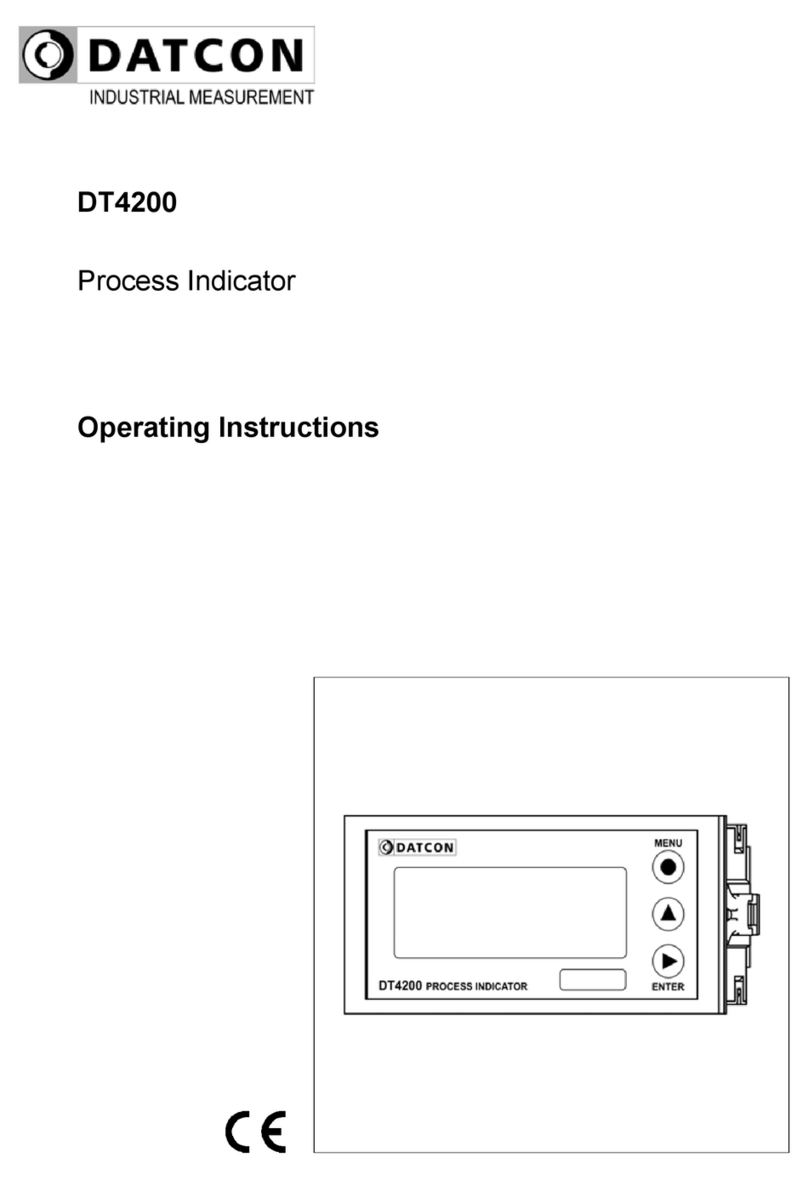
Datcon
Datcon DT4200 User manual
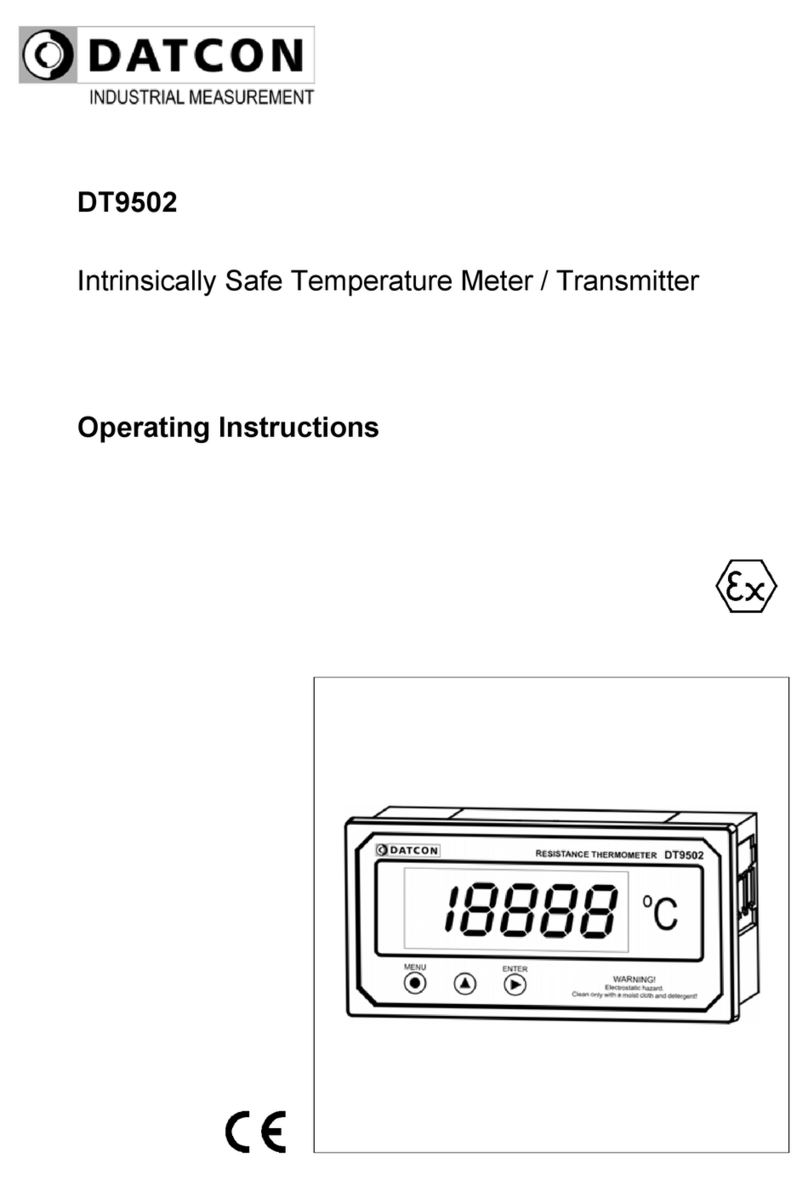
Datcon
Datcon DT9502 User manual

Datcon
Datcon DT4260 Series User manual
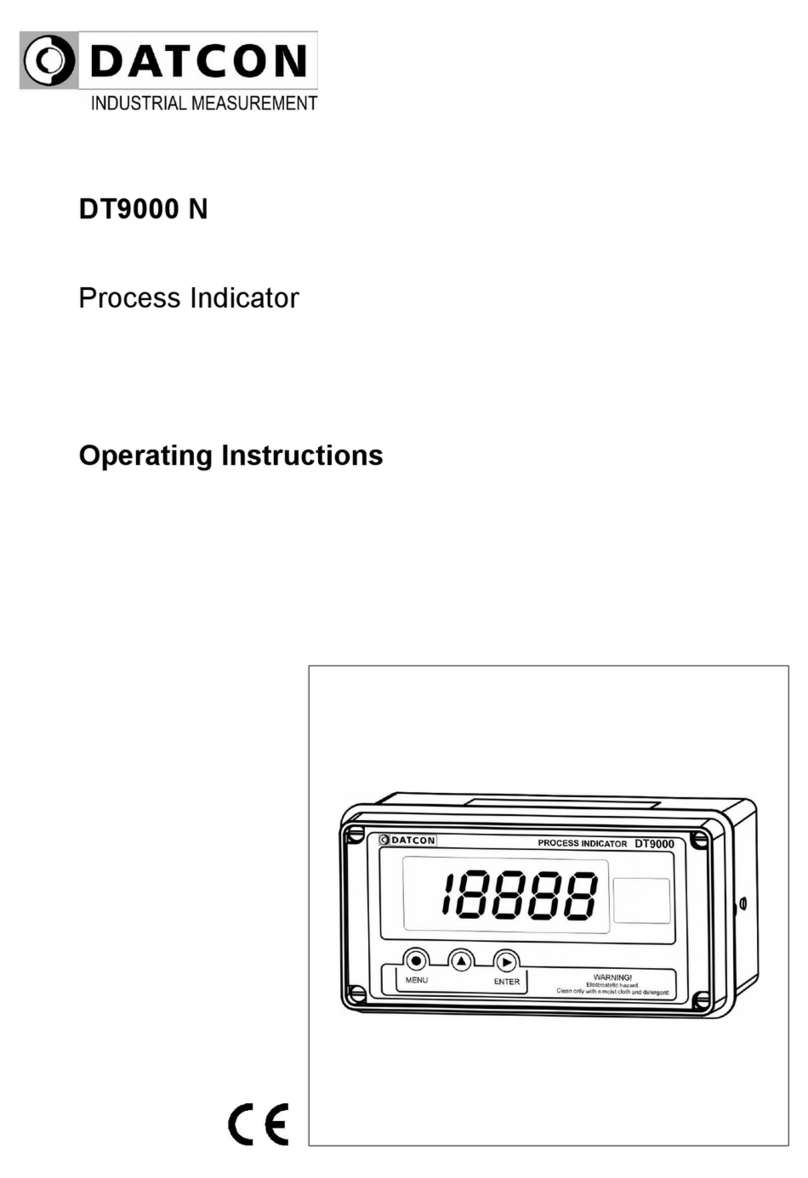
Datcon
Datcon DT9000 N User manual
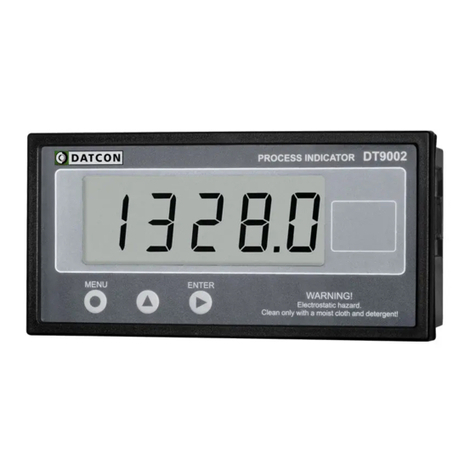
Datcon
Datcon DT9002 User manual
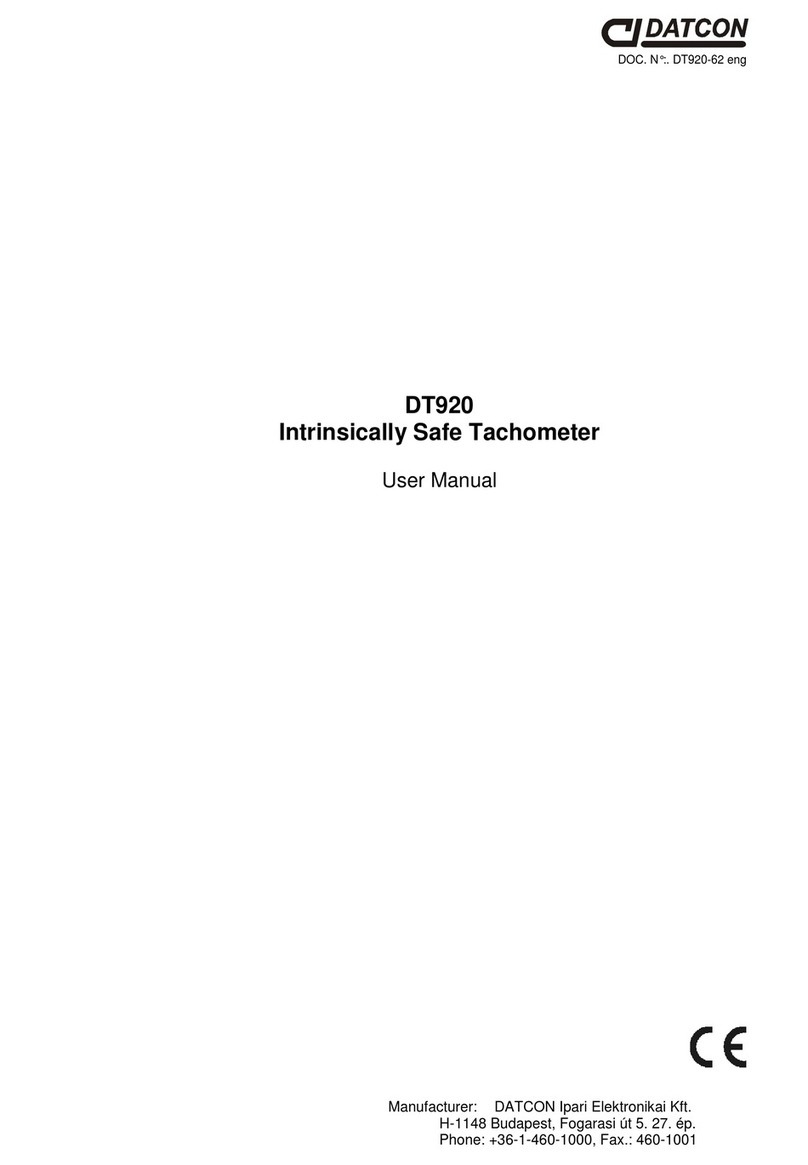
Datcon
Datcon DT920 User manual
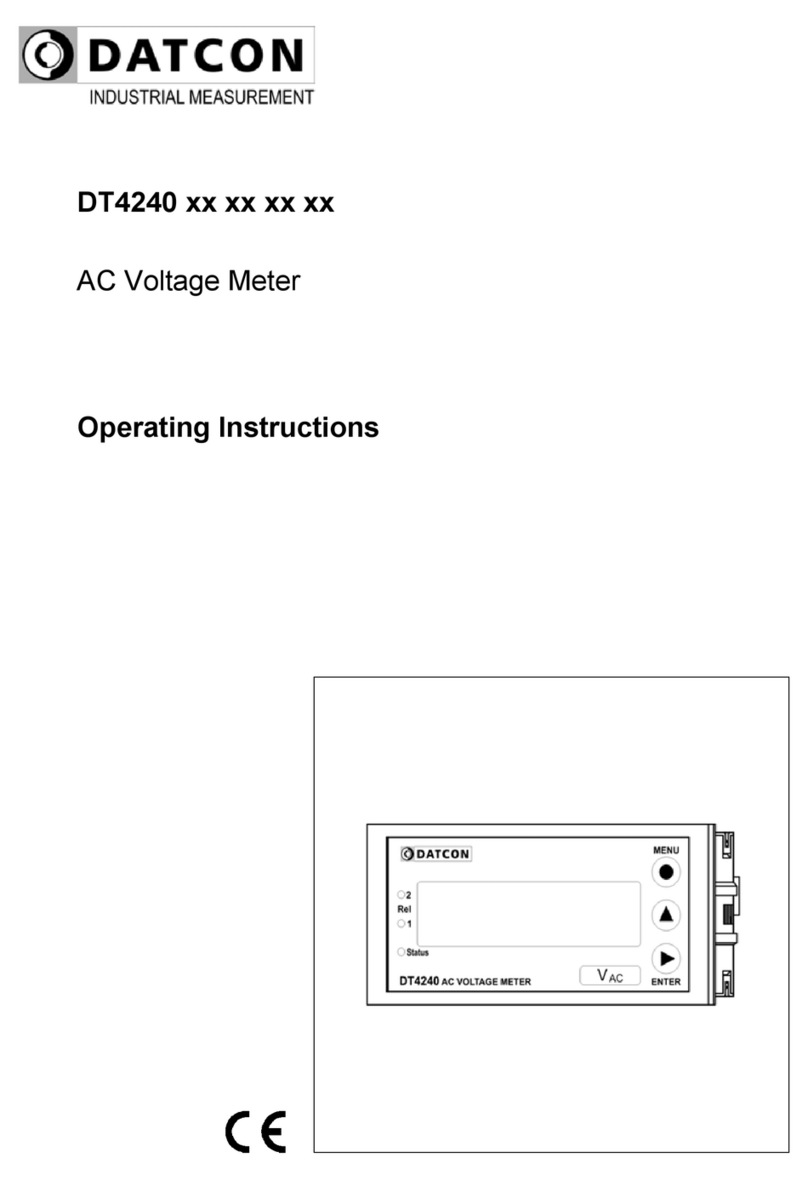
Datcon
Datcon DT4240 Series User manual
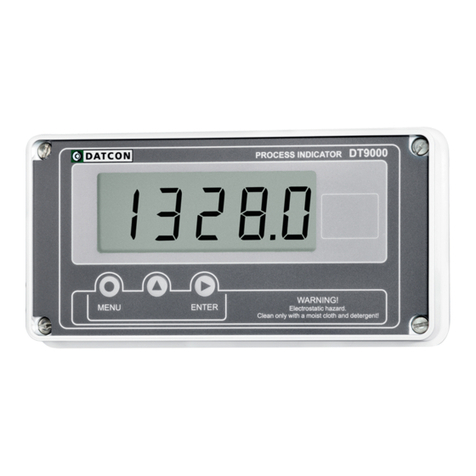
Datcon
Datcon DT9000 User manual
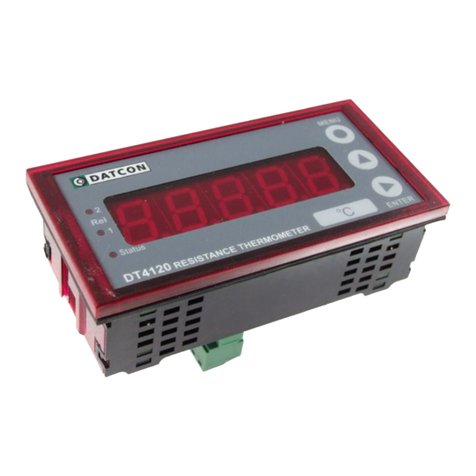
Datcon
Datcon DT4120 Series User manual

Datcon
Datcon DT7000 User manual
